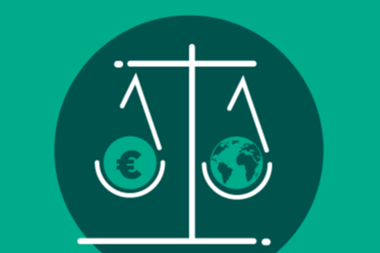How can environmental, social and governance (ESG) criteria be incorporated into fixed-income portfolios? When a pension fund as large as Japan’s $1.37trn (€1.15trn) Government Pension Invest-ment Fund (GPIF) asks such a question, attention is focused not just on the answer, but on why that the question is being asked in the first place.
The GPIF started to incorporate ESG elements into its equity portfolio in 2017 via passive ESG index investing – including following MSCI’s Japan Empowering Women Index (WIN). However, with half of its investments in fixed income (predominantly sovereign bonds), the GPIF is considering the applying ESG across asset classes.
The GPIF asked the World Bank Group, as a leading player in the green-bond market, to partner with it to identify leading ESG approaches used by international asset owners, fund managers as well as service/data providers in the fixed-income sector. A key goal of the project is to help institutional investors to deploy capital at scale on a more sustainable basis.
The GPIF team is right that incorporating ESG into fixed-income investments is different. The main focus here is on risk analysis – that is, the downside capital risk and cash-flow stability versus capital appreciation. The importance of sovereign bonds is another fundamental difference to equities. On top of the general difficulties with ESG investing (such as varying definitions, standards, methodologies; and different beliefs, especially in social matters), there are several themes specific to fixed income, including:
• Data for many fixed-income instruments is still limited – both in terms of quantity and quality – notably for smaller issuers and those in emerging markets.
• Engagement is at the heart of many investors’ ESG approaches, but how to handle engagement when it comes to fixed-income issuers (particularly sovereigns, given the absence of shareholder rights)?
• There is a dearth of ESG index products and ESG investment tools compared with the equity space.
• What are material factors in terms of E, S and G over the different maturities within a fixed-income portfolio? What role does ESG play in credit ratings?
• There are also challenges in the green/climate bond markets, with demand outstripping supply.

That said, our research for the project – involving an extensive literature analysis as well as structured interviews with leading players in this field – found that ESG investing has finally gained momentum in fixed income. Corporate bonds are catching up fast with equity investments in integrating ESG factors – including more active engagement with issuers of debt. Other fixed-income asset classes, such as sovereign bonds, high yield, asset-backed securities or private debt have further to go.
Indeed, a growing body of research shows that ESG factors are a material credit risk for fixed-income investors. Evidence suggests that incorporating ESG should be part of their overall credit-risk analysis and does not mean having to sacrifice investment returns.
Various methods for how investors are incorporating ESG into their fixed-income portfolios are emerging – from purchasing thematic investments (such as green, social or sustainable bonds, and ESG/SRI funds), to following ESG indices, hiring active ESG managers, and embedding ESG across the whole investment process. These can be done by following the in-house methodology of specific service providers or by customising strategies with the institutional investor’s own philosophy. The leading large investors tend to have a full organisational approach (starting at board level) as well as clear and transparent ESG and climate-change objectives. Smaller investors, however, often tend to find their options curtailed in practice.
One trend surprised us both in terms of the attention it is attracting, as well as the pace of change. There is a growing attention to outcomes, going well beyond the traditional emphasis on ESG inputs and process. ESG is becoming not just an aspect of risk and return, but is also merging with impact investing.

Despite the increasing evidence around materiality, and the growing will by mainstream investors, further incorporating ESG into fixed-income portfolios will take more work. The lack of clear terminology is also causing questions around who regulates sustainability. How to distinguish between material analysis and green-washing? ESG and climate-change regulation is changing, but remaining challenges around fiduciary duty and ESG incorporation are live.
To address some of these problems, we have proposed that the GPIF and World Bank partner and lead in the following areas:
• Continuing initiatives to improve the breadth and depth of ESG data need to be supported. These include National Capital Accounting programmes, as well as corporate reporting developments led by the Task Force on Climate-Related Disclosures (TCFD). Non-corporate sources of information (big data, satellite information) can provide more timely signals and fill in data gaps. The World Bank and International Finance Corporation (IFC) can start by making their own considerable sources of ESG data and impact studies on emerging markets more readily accessible to investors.
• Conceptual work on ESG and fixed income needs to go beyond credit risk. Further robust academic studies would be welcome, including on other market risks such as inflation or liquidity over different yield structures. Sovereign analysis is a good place to start.
• Refining standard principles and metrics for applying ESG and impact investing is much called for. This will allow investors to customise their approach from a robust basis to reflect their own beliefs and goals.
• Finally, rolling out more innovative products to accommodate the growing demand for fixed-income sustainable investments. They should be scalable and more diverse to become meaningful portions of investors’ asset allocation and benchmarks.
Ultimately, investing is about dealing with opportunities and uncertainties – this is no different for ESG investing. ESG issues constitute a formidable challenge for asset owners and managers but also provide new – financial and social – opportunities, especially in fixed income, given its huge volumes. In any case, investors – especially index investors – are coming under more scrutiny for their ESG efforts, as well as for their environmental and social impact.
Fiona Stewart is a lead finance sector specialist in the finance, competitiveness and innovation global practice of the World Bank. Georg Inderst is an independent adviser to pension funds, institutional investors and international organisations


























.jpg)






No comments yet